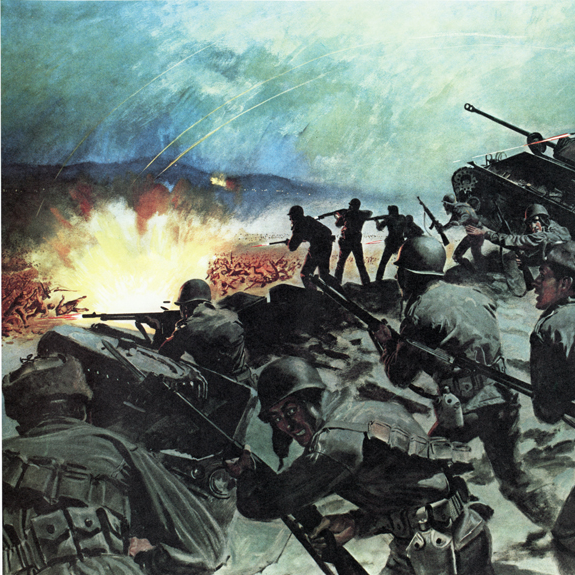Korean War
Korean War, 1950–1953
The Korean War was the first “hot” conflict in what soon became known as the Cold War. It would prove a costly and frustrating conflict, with rapidly fluctuating territorial gains over the course of four years, exceptionally brutal weather conditions, and atrocities committed on both sides.
As imperial Japan relinquished command of Manchuria and the Korean Peninsula at the end of World War II, a race began to establish political and military control of the region. In short order, the Soviet Union, the People's Republic of China, and the United States all strove to define Korea's political future. The Democratic People's Republic of Korea (North Korea) soon adopted a vigorous pro-communist stance, favoring its Chinese and Soviet allies. In the south, the semi-despotic and nominally democratic Republic of Korea, under the regime of Syngman Rhee, sided with the west. Fighting began on the peninsula as early as 1945 − long before the U.S. officially became involved − as the Korean nation was polarized by divisive political ideologies.
As the United States strove to restrict the spread of communisim via its policy of Containment and the Soviets pushed to advance their own agendas, Korean leaders uneasily agreed to split their nation at the 38th parallel in September 1945. But this resolution was not peaceful for long. The people of the North, spurred on by charismatic leader Kim Il Sung, wished to reunite the nation under a communistic government.
North Korea invaded the South in May 1950, and by November controlled nearly 80% of South Korean territory. The United States and the United Nations unanimously condemned the North Korean invasion. The Soviets boycotted the UN in protest of a referendum on military intervention on the peninsula. As a result, the UN was able to approve measures to intervene on the behalf of the South. The United States spearheaded the UN advance, driving the North back at the battles of Inchon, the Pusan Perimeter. By late 1951, the United States and the UN allied powers had driven North Korean forces nearly to the Yalu River, the border of North Korea and China. At this point, the Chinese sent hordes of revolutionary fighters—the People’s Volunteer Army –to drive the south and its allies back. The massive Chinese advance cost the lives of thousands of South Korean and allied soldiers, pushing their armies back to the 38th parallel.
For the next two and a half years, a bloody stalemate ensued. Neither the Chinese backed North, nor the UN supported South was able to break down their enemies defenses by use of conventional tactics. As the body count rose with limited hope of success for either side, negotiations for ceasefire began. Towards the end of 1952, a limited ceasefire began to take hold across regions of the peninsula. It was soon formalized; a general armistice was declared between the Koreas on July 27th, 1953. To this day, the two nations remain technically in a state of war, as peace was never officially declared.
